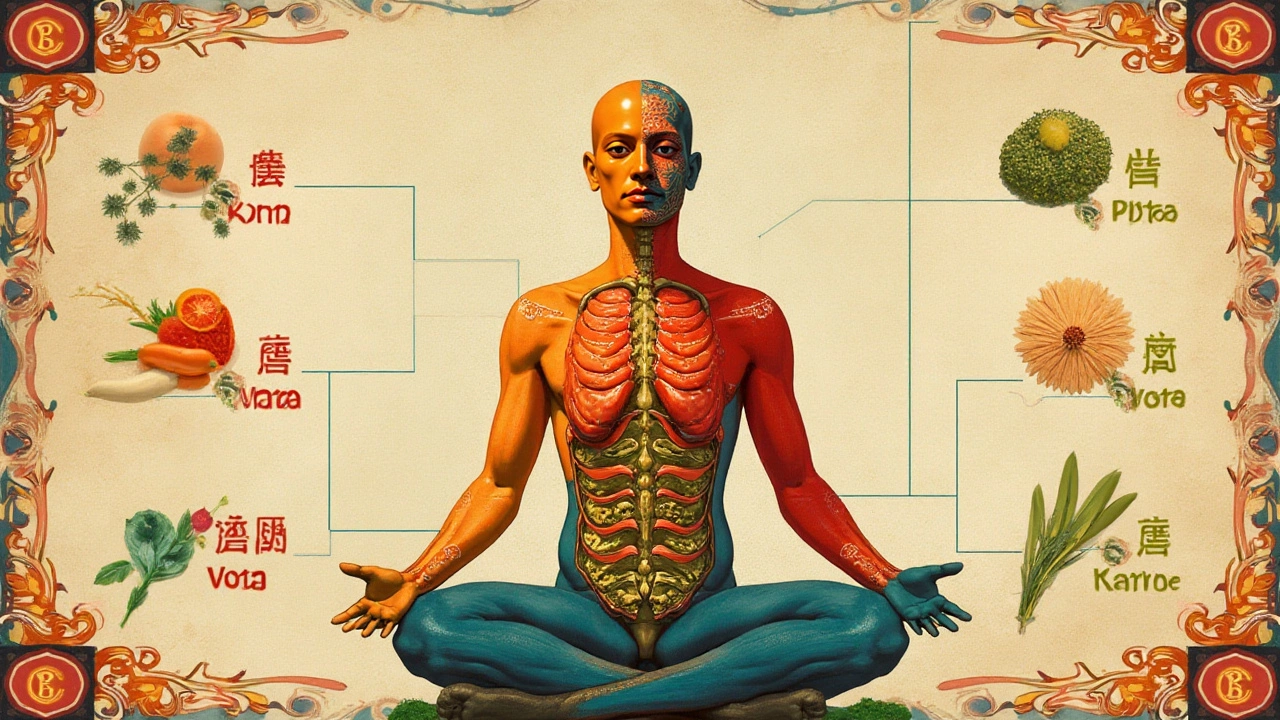Within the broad and detailed framework of Ayurveda, every element has its own significance, including the foods we consume daily. Unlike many modern dietary guidelines, Ayurveda tailors its approach to individual bodies and unique constitution types, known as doshas. It's a world where imbalance can easily lead to inflammation, causing discomfort and disrupting harmony.
An ancient system that thrives on balance, Ayurveda highlights certain foods that can potentially stir inflammation within the body. As each dosha represents different energy types and body functions, feeding them inappropriately could spell trouble. Grappling with this concept calls for awareness of what on your plate could fuel an inflammatory response. By paying attention to your body's needs, aligned with Ayurvedic wisdom, you can enhance your well-being and counteract unwanted symptoms.
- Understanding Inflammation in Ayurveda
- Common Inflammatory Foods
- Balancing Doshas through Diet
- Modern Dietary Influences
- Tips for a Balanced Diet
Understanding Inflammation in Ayurveda
Ayurveda, an ancient system of medicine originating from India over 5,000 years ago, offers a unique perspective on health, particularly on how inflammation manifests within the body. In Ayurveda, inflammation is not just a physical condition; it is a disruption of balance among the three primary doshas: Vata, Pitta, and Kapha. These doshas represent various combinations of the five elements - earth, water, fire, air, and space. The balance of these doshas is crucial, and even minor disturbances can lead to conditions like inflammation.
Ayurvedic practitioners view inflammation primarily as a result of an overactive Pitta dosha, which is closely linked to the elemental fire. Pitta governs heat, metabolism, and transformation in the body, making it prone to excessive stimulation. When Pitta is aggravated, symptoms such as redness, heat, and swelling often ensue, reflecting the very nature of inflammation. However, that's not to say the other doshas aren't involved. A disharmony in Vata, for instance, can lead to erratic movements and contribute to inflammation through a different pathway, often manifesting as joint stiffness or pain.
According to Ayurveda, inflammation can also arise from external factors such as dietary choices, environment, and emotional stress. Foods that are excessively spicy, sour, or fried are known to spike Pitta and should be consumed in moderation. In fact, Ayurvedic teachings often stress the importance of 'Agni', the digestive fire, as a key indicator of overall health. When Agni is strong, digestion is efficient, and the risk of inflammation decreases. Conversely, when it is compromised by poor dietary habits or stress, toxins or 'Ama' begin to accumulate, leading to inflammation.
Ayurveda doesn’t just stop at diagnosing the cause of inflammation; it also provides solutions involving a holistic lifestyle. Practitioners often recommend personalized diets, meditation, yoga, and herbal treatments to bring doshas back into balance. Such recommendations are not only personalized but also seasonally adjusted, acknowledging the idea that nature’s cycles deeply influence our internal states. The focus is not merely on reactive care but on sustaining preventative practices that nurture well-being over the long term. Inflammatory foods are avoided as part of this preventative strategy, with an emphasis on whole, seasonal, and unprocessed ingredients that align with one's doshic constitution.
Common Inflammatory Foods
In the intricate world of Ayurveda, foods are not merely sustenance; they are powerful tools that can either fortify the body's health or stoke the embers of inflammation. Ayurveda looks at inflammation not simply as a physiological reaction but as a manifestation of a deeper imbalance within the body's doshas: Vata, Pitta, and Kapha. Certain foods, when consumed without regard for an individual's dosha type, can lead to excess heat and irritability in the system, often seen as Pitta aggravation. Foods that are overly spicy, acidic, or sour can tip the doshas out of balance, resulting in an inflamed state.
Among the foods often flagged in Ayurveda for their inflammatory potential are those that are highly processed or high in sugar. These modern dietary staples can disturb all doshas but primarily aggravate Pitta. Fried foods, for instance, are not just about added calories; they introduce unnecessary heat into the body, disrupting digestive harmony. Refined sugars, aside from causing spikes in blood sugar, can ferment in the gut, leading to discomfort and a fiery response internally. Dr. Robert Svoboda, a respected scholar in Ayurvedic medicine, noted that "what feeds the flames of Pitta can often scorch the balance across the board," highlighting the need for mindful consumption.
Ayuvedic teachings also point to common allergens like dairy and gluten as potential inflammatory agents. While not universally problematic, these foods can trigger inflammation when consumed in excess or by those sensitive to them. In Ayurveda, dairy is considered heavy and mucus-forming, possibly disrupting Kapha balance and leading to congestion and sluggishness. Similarly, wheat and gluten are seen as problematic when improperly digested, often due to the predominance of refined grains. Choosing whole grains and ghee in place of butter can mitigate such effects. Implementing a balanced approach to spicy and sour foods, such as moderating the intake of hot peppers and citrus fruits, is another step towards reducing these inflammatory risks without compromising on flavor.

Balancing Doshas through Diet
In the profound universe of Ayurveda, where harmony is king, the art of balancing doshas through diet holds the key to reducing inflammation and promoting optimal health. Each dosha, Vata, Pitta, and Kapha, serves a specific purpose and thrives under different dietary conditions. It is fascinating to see how Ayurveda categorizes food into six tastes—sweet, sour, salty, bitter, pungent, and astringent—each having a unique impact on the doshas. For instance, a Vata constitution, often associated with air and space, benefits from warm foods and spices that stabilize their lively energy, like soups and stews, complemented with healthy oils.
Another interesting component is the role that seasonal adjustments play in maintaining dosha balance. Each season aligns with certain doshas and thus, requires adaptations in one's diet to accommodate these influences. Pitta individuals, with their fiery constitution, should focus on cooling foods, particularly in the hot summer months. Think of fresh cucumbers, melons, and leafy greens playing a critical part in maintaining inner coolness. This brilliant interplay underscores the Ayurvedic understanding of food as medicine, where nothing is static, and adaptation is vital.
Moreover, the dosha-balancing diet isn't merely about what to eat but also how to eat. In Ayurveda, the method of eating is considered equally essential. It advises mindful eating practices such as eating in a peaceful environment without distractions and at regular times, bringing a meditative quality to the simple act of nourishing oneself. By adhering to these practices, the body fires up its digestive 'agni', or digestive fire, more effectively, which is pivotal to keeping inflammation at bay.
"Let food be thy medicine and medicine be thy food," said Hippocrates, a sentiment resonating strongly within the Ayurvedic philosophy.
There's a wealth of evidence supporting the idea that these dietary tailorings can significantly modulate inflammation. Anecdotal accounts and traditional wisdom emphasize how respecting one's unique dosha can dynamize one's energy and well-being, reducing the bloating, digestive issues, and skin flare-ups commonly associated with inflammatory processes. Practical application of this knowledge involves understanding and implementing these principles into daily dietary habits—for instance, indulging in a slice of ginger before meals to stimulate digestion for Vata types or choosing cooling mint teas for Pitta to pacify their natural heat.
For someone with a Kapha disposition, balancing diet through Ayurveda involves incorporating light, spicy, and invigorating foods that counteract their earthy and watery nature. Lighter grains, an abundance of fresh vegetables, and the limited indulgence of sweets can prevent the sluggishness typical of Kapha imbalances. By focusing on such dietary characteristics, Ayurveda not only aims to quell inflammation when it arises but strives to prevent it by aligning with nature's cycles and the body's inherent constitution.
This approach, with its nuanced and empathetic tailoring, provides a comprehensive and sustainable pathway to wellness. Embracing one's dosha-specific dietary needs doesn't require dramatic overhauls but invites small, thoughtful changes—choosing foods which resonate with one's bodily rhythms. In today’s fast-paced world, the Ayurvedic diet remains a beacon of ancient wisdom seamlessly blending with modern health consciousness, proffering an antidote to inflammation through heritage and insight.
Modern Dietary Influences
In the fast-paced whirl of modern life, dietary influences have taken center stage in shaping our health narratives, often veering away from the principles espoused by Ayurveda. The rise of processed foods and fast-food culture has introduced an array of ingredients that may not sit well with our bodies, sparking inflammatory responses. Ingredients such as refined sugars, artificial additives, and trans fats are prevalent in today's meals, creating a storm within. The pursuit of convenience often leads to choices that aren't aligned with natural body rhythms or the nutritional wisdom gleanar over centuries. Many of us are unfortunately accustomed to quick fixes and instant meals, which do little to nurture the intricate balance of our internal systems.
Ayurveda offers an insight into how diet heavily impacts our doshas, with the continuous consumption of inflammatory foods potentially tipping this balance. With an ever-increasing variety of choices, it’s easier than ever to indulge in foods that can be aggravating. Scientific research supports this, highlighting how prolonged exposure to these ingredients often results in chronic inflammation. According to a 2019 study published in 'Nutrients,' 68% of the average American diet is made up of processed food. Such diets can aggravate the doshas, especially Pitta, responsible for many inflammatory conditions.
"Our diet today is often a far cry from the natural, whole foods that our bodies are designed to process," notes Dr. Maya Feller, a renowned nutritionist, emphasizing the need to return to simpler, less processed food sources.
Interestingly, modern science now aligns with Ayurvedic wisdom in many ways, recognizing the detrimental role of certain dietary habits. The typical Western diet, high in omega-6 fatty acids and low in omega-3s, has been linked to increased levels of inflammation, showcasing the alignment between contemporary findings and ancient practices. To counteract these influences, incorporating more omega-3 rich foods such as flaxseed and walnuts, along with practicing mindful eating, can be greatly beneficial. Rediscovering a relationship with seasonal and local produce, as Ayurveda suggests, can help in realigning our diet to more nurturing patterns.
Given the bustling nature of our daily lives, maintaining an anti-inflammatory diet might seem daunting. However, prioritizing meals that are freshly prepared, understanding the impact of food choices on our holistic health, and making incremental steps towards reducing processed food intake can facilitate a more balanced lifestyle. Adopting Ayurvedic practices like incorporating herbs and spices geared to soothe rather than ignite the body's fire can play a pivotal role. As we become more aware of how body and health are affected by diet, modern influences can be adapted and tuned to better fit ancient insights, serving a bridge between the past and our present culinary habits for nurturing wellbeing.

Tips for a Balanced Diet
Achieving a balanced diet through Ayurveda is both an art and a science, deeply rooted in understanding your body's unique needs. One of the keys is to harmonize the doshas, which are biological energies found throughout the human body and mind. They govern all physical and mental processes and provide an individual blueprint for health and fulfillment. Integrating a diet that caters to your predominant dosha is highly beneficial. A well-rounded, Ayurvedic diet focuses on quality, variety, and the necessity of eating according to the season, time of day, and one’s age. Mastering these principles involves prioritizing whole, unprocessed foods and avoiding inflammatory substances.
An effective approach involves eating fresh, organic produce, and favoring meals cooked with aromatic spices like turmeric, cumin, and ginger. These spices not only enhance flavor but are known for their anti-inflammatory properties. To battle inflammation, limit or avoid foods high in processed sugar, trans fats, and refined grains, as these can aggravate the body’s inflammatory responses. Incorporating a variety of vegetables, fruits, whole grains, lean proteins, and healthy fats is crucial. Eating mindfully, chewing thoroughly, and dining in a tranquil setting also contributes significantly to how well your body can process the nutrients.
It's insightful to remember the words of Dr. Deepak Chopra, a renowned advocate for Ayurvedic health, who once said,
"The Ayurvedic route to great health involves two simple steps: doing less and being more."This philosophy transcends into diet, suggesting that simplicity and mindfulness in arrangements of meals can lead to significant health benefits. Complementing your diet with regular physical activity and stress management practices such as yoga or meditation can help maintain the balance crucial to optimal health.
For a more practical application of these tips, consider creating a weekly meal plan that aligns with the principles of Ayurveda. Begin each day with a warm, hydrating beverage like lemon water or herbal tea. Plan your main meals with a focus on variety, ensuring that they contain all six tastes—sweet, sour, salty, bitter, pungent, and astringent—as advocated by Ayurvedic guidelines. Here is a simple breakdown of enhancing your plate:
- Sweet: think whole grains and natural sweeteners like honey;
- Sour: bring in citrus fruits or fermented foods like yogurt;
- Salty: of course, used sparingly, sea salts and naturally salty foods;
- Bitter: leafy greens and sprouts qualify;
- Pungent: spices like ginger and black pepper perform well;
- Astringent: lentils, beans, and raw fruits and vegetables.





